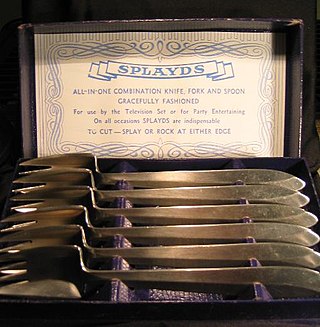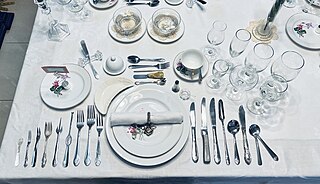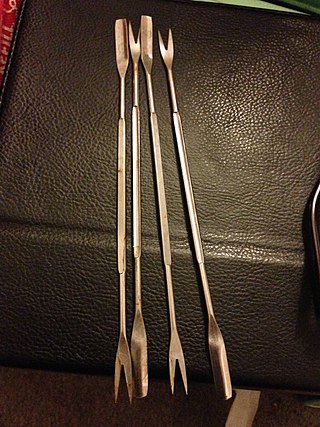
A spoon is a utensil consisting of a shallow bowl, oval or round, at the end of a handle. A type of cutlery, especially as part of a place setting, it is used primarily for transferring food to the mouth. Spoons are also used in food preparation to measure, mix, stir and toss ingredients and for serving food. Present day spoons are made from metal, wood, porcelain or plastic. There are a wide variety of spoons that are made of a variety of materials and by different cultures for many different uses and foods.

In cutlery or kitchenware, a fork is a utensil, now usually made of metal, whose long handle terminates in a head that branches into several narrow and often slightly curved tines with which one can spear foods either to hold them to cut with a knife or to lift them to the mouth.

A spork is a form of cutlery and combination utensil taking the form of a spoon-like scoop with two to four fork-like tines. Spork-like utensils, such as the terrapin fork or ice cream fork, have been manufactured since the late 19th century; patents for spork-like designs date back to at least 1874. Sporks are commonly used by fast food restaurants, schools, prisons, militaries, backpackers, and airlines.

Various customary etiquette practices exist regarding the placement and use of eating utensils in social settings. These practices vary from culture to culture. Fork etiquette, for example, differs in Europe, the United States, and Southeast Asia, and continues to change. In East Asian cultures, a variety of etiquette practices govern the use of chopsticks.

A garden fork, spading fork, or digging fork is a gardening implement, with a handle and a square-shouldered head featuring several short, sturdy tines. It is used for loosening, lifting and turning over soil in gardening and farming, and not to be confused with the pitchfork, a similar tined tool used for moving loose materials such as hay, straw, silage, and manure.

A mess kit is a collection of silverware and cookware designed for use by military personnel for food and military rations. They may also be used during camping and backpacking. There are many varieties of mess kits that militaries issue to their personnel that later become available to consumers.

A kitchen knife is any knife that is intended to be used in food preparation. While much of this work can be accomplished with a few general-purpose knives – notably a large chef's knife, a tough cleaver, a small paring knife and some sort of serrated blade – there are also many specialized knives that are designed for specific tasks. Kitchen knives can be made from several different materials.

A splayd is an eating utensil combining the functions of spoon, knife and fork. It was invented by William McArthur in the 1940s in Sydney, New South Wales, Australia. There are several manufacturers.

A full-course dinner is a dinner consisting of multiple dishes, or courses. In its simplest form, it can consist of three or four courses; for example: a starter, a main course, and dessert.

Table manners are the rules of etiquette used while eating, which may also include the use of utensils. Different cultures observe different rules for table manners. Each family or group sets its own standards for how strictly these rules are to be followed.

Tines, prongs or teeth are parallel or branching spikes forming parts of a tool or natural object. They are used to spear, hook, move or otherwise act on other objects. They may be made of wood, bone, metal, or similar materials.

A kitchen scraper is a kitchen implement made of metal, plastics, wood, rubber or silicone rubber. In practice, one type of scraper is often interchanged with another or with a spatula for some of the various uses.

A kitchen utensil is a small hand-held tool used for food preparation. Common kitchen tasks include cutting food items to size, heating food on an open fire or on a stove, baking, grinding, mixing, blending, and measuring; different utensils are made for each task. A general purpose utensil such as a chef's knife may be used for a variety of foods; other kitchen utensils are highly specialized and may be used only in connection with preparation of a particular type of food, such as an egg separator or an apple corer. Some specialized utensils are used when an operation is to be repeated many times, or when the cook has limited dexterity or mobility. The number of utensils in a household kitchen varies with time and the style of cooking.

A crab fork is a small type of seafood fork designed for extracting flesh from a crab or lobster. These forks are typically long and narrow and are used for separating the meat of a crab or lobster from the shell. Crab forks may be special-purpose food utensils decorated or constructed specifically for crabs and lobsters, or may simply be very small forks sold or used for the purpose.

Chopsticks are shaped pairs of equal-length sticks that have been used as kitchen and eating utensils in most of East and Southeast Asia for over three millennia. They are held in the dominant hand, secured by fingers, and wielded as extensions of the hand, to pick up food.

The cuisine of Gower, a peninsula in south Wales, is based on ingredients grown, raised or collected on or around the peninsula. The cuisine is based on fresh ingredients with recipes based around a fish or meat dish. Until the twentieth century, the peninsula was virtually cut off from other markets due to poor roads, and no rail connection. The result was that Gower became self-sufficient in food.
The lemon fork is a small serving utensil that is used to move lemon slices. Lemon forks have three long tines, with the outside tines splayed; ostensibly this arrangement helps to release more juice. Lemon forks became popular in the last quarter of the 19th century alongside other specialized utensils, such as asparagus tongs. One early 20th century cookbook called the lemon fork a "necessity" at the five-o-clock tea party. At table settings, the fork was placed over the slice of lemon. Unlike many specialized utensils, lemon forks are still used in the 21st century, primarily in the restaurants.

The fish knife together with fish fork represent a set of utensils specialized for eating fish. Fish knife is a strange-looking, purposedly blunt implement.

The fish fork, sometimes along with the fish knife, is an eating utensil specialized for fish meals. Like most highly specialized utensils, the fork dates back to Victorian era. With the length of about 7.5 inches, the distinctive features might include a wide left tine or a deep notch that can be fit over the bones. To avoid the chemical reaction with the acidic lemon and associated metallic taste, the fork was traditionally, until the arrival of stainless steel in the 1920s, made of silver.


















